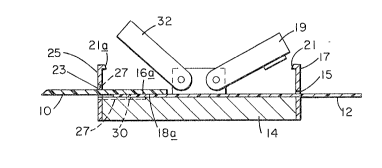Note: Descriptions are shown in the official language in which they were submitted.
TITLE
High Density Flex Connector System
Background of the Invention
This invention is directed to the alignment of a
connector to a printed wirin~ board (PWB).
The preparation and alignment of connectors to a
PWB has been generally carried out by a complex, exacting
process u6ing the PWB edges for po6itioning the ~onnector
fingers relative to the PWB contact pads. The known
10 positioning ~ystems are not capable of positioning
connector on center~ of much less than 50 mils. A system
has been developed for reducing the complexity and
incre~ing the reliability of the alignment of such
connections.
Su~mary of the Invention
Thi6 invention provides a high density flex
connector system capable of accurate alignment of the
connector fingers with pads of a printed wiring board.
The mean6 for alignment includes a photodefined fir6t
guide located at ~ach 6ide of an array of pads located at
the ends of traces of a printed wiring board and a
photodeined second guide located at each side of an array
of connector fingers at the ends of traces on a flex
connector. The first and second guides intermesh ~s
connector ~inger~ are guided into an overlapping position
with the pads to preci6ely align the fingers with pads.
Similarly, meshing guides located ~lightly ahead of said
first and ~econd guides and with greater longitudinal
and lateral travel during meshing than the first and
second guides to provide a coarse alignment pr;or to
~e~hing o~ the fir6t and 6econd guides.
Brief Description of the Drawin~s
Fig. 1 i~ a perspective view of a connection
~ystem that utilizes the invention.
~iq. 2 is a ~ectioned view of Fig. 1 taken along
line 2-2.
'~
Fi~. 3 is a sectioned view of Fig. 1 taken along
line 3-3.
Fig. 4 is an enlarged view of a portion of Fig.
3.
Fig. 5 is an enlarged partial plan view of the
overlap connection between the PWB and the flex connector.
Fig. 6 i~ an enlarged partial view of Fig. 5.
Detailed Description of the Preferred ~mbodiment
Referring now to Fig. 1, the embodiment chosen
for purpose~ of illustration includes a printed wiring .
board 10 and a flex connector 12 joined together in ~n
overlapping relationship within clamping connector housing
~4. The overlapping relationship i~ best ~hown in Fig6.
2, 5 and 6 wherein PNB lO and flex connector 12 have
photodefined trace~ 16, 16 respectively applied to opposed
~urfac~s 16a, lBa in a manner well known in the art. The
traces 16 terminate in an array of connector pads 20 while
the traces 18 terminate in an array of fingers 22. The
means for aligning the PWB with the flex connector
includes guide arrangements attached both to the Pws and
the flex connector. More particularly, referring to Fig.
5 vee-shaped fir6t guides 26 are located at each side of
the array of connector pads 20 on PWB 10 and wedged-shaped
second guides 24 are located at each side of the array of
fingers 22 of the flex connector 12. The guide~ 24, 26
are photodefined at the time the trace~, pad6 and finger~
are photodefined, i.e., all in one operation. In addition
to guides 24, 26 ~lotted third guides 2B are located at
each ~ide of the array of fingers 22 on the flex connector
12 at its leading edge 12a. These guides ~8 have a ~lot
28a in them to accept an alignment pin 30 mounted at each
6ide of the array of pad~ 20 on PW~ 10. The guides 28 are
photodefined on connector 12 while pin~ 30 are made of
~teel and are inserted in holes on PW~ 10. ~uid~s 28 and
3 ~ 3~717
pins 30 form a coarse alignment arrangement to bring
guides 24, 26 to approximate alignment before they mesh to
provide precise alignment of the fingPrs 22 with the pads
20. Since the pads ~nd fingers overlap, the guides 24, 26
are plated to a thickness of the overlap so they will
engage as the PWB overlap the flex connector in housing
14. Electrical traces 31,32 located on flex connector 12
and PWB 10 respectively provide an electrical path to the
edges of the flex connector and PWB to enable
electroplating up of the guides 24,26,28. In addition
these trace~ provide vertical po~itioning of the flex
connector relative to the P~B during the joining procsss
60 that the fingers 22 properly overlap the pads 20.
The ho~ing 14 i6 used to 6queeze PWB lO and
flex connector 12 together to make contact between pad~ ~0
and fingers 22. Flexible connector 12 enters hou~ing 14
through a ~lot 15 in end wall 17 of the housing and is
clamped in place by pivoting lever 19 which locks in place
under a lip 21 of wall 17. The PWB enters housing 14
through a ~lot 23 in end wall 25 of the housing. Slot 23
has enlargements 27 to allow pins 30 on PWB lO to pass
through. When the Pws is in position overlapping
connector 12 as 6hown with ~urfaces 16a, l~a facing each
other, a pivoting lever 32 squeezes them together to make
contact between the pads 20 and fingers 22. The lever
lock6 in place under a lip 21a of wall 2S.
Since the alignment quides 24, 26 and the traces
wi~h fingers and pads on the connector and PWB are
photodefined in one operation, an absolute positioning
reference ~y~tem i~ establi~hed which permit~ po itioning
o~ c~nnector pad~ on much clo6er centers on the PW~ than
previou~ly po~ible.
3~
